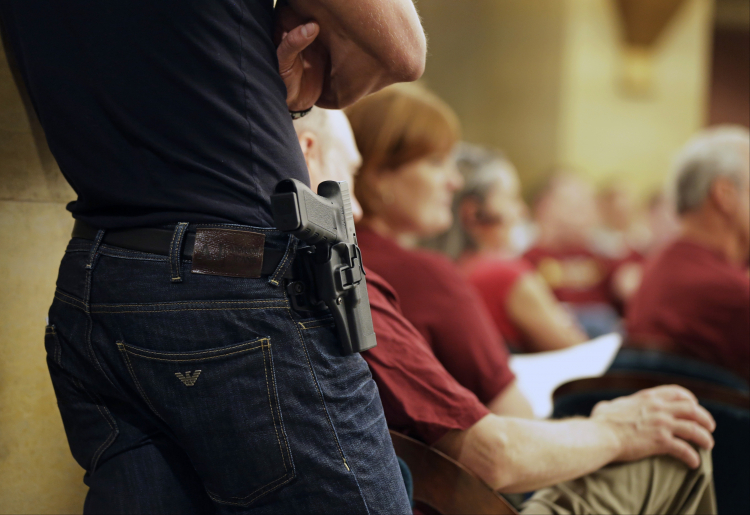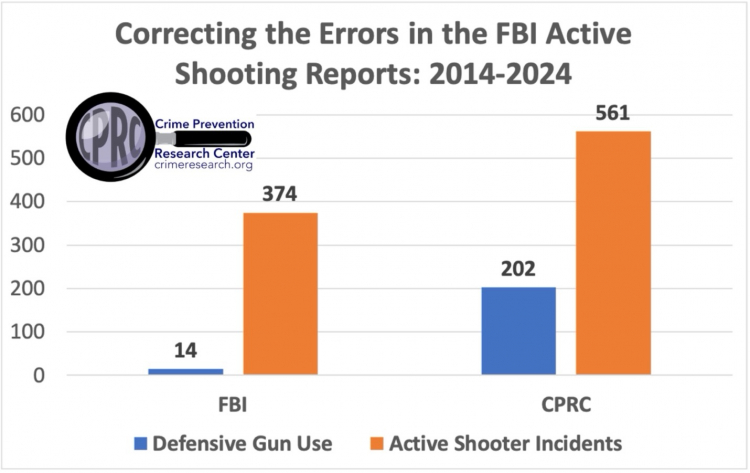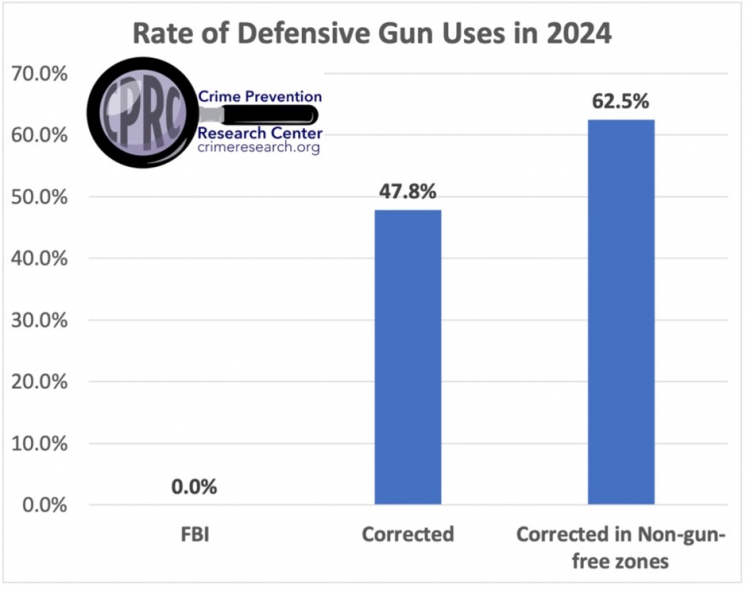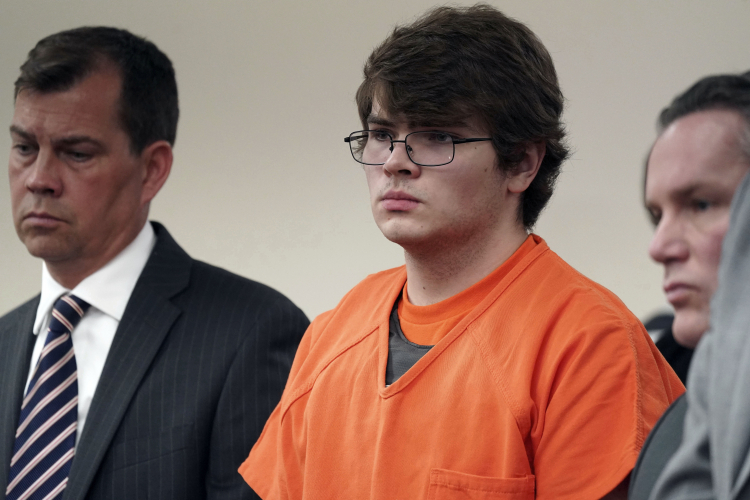Three years ago, RealClearInvestigations reported that the FBI was undercounting the number of armed civilians who had thwarted active shooters by a factor of three.
Even though the FBI acknowledged the issue at the time, it never corrected the error involving the politically fraught issue. In the years since, the problem has only gotten worse. Since RCI’s 2022 article, the FBI has acknowledged just three additional incidents of armed good Samaritans stopping active shooters from 2022 to 2024, and none in the last two years. In contrast, the Crime Prevention Research Center (CPRC), which I head, has documented 78 such cases over that same period – a 26-fold difference.
The discrepancy highlights systemic problems in the nation’s record-keeping regarding the politically potent issue of crime and safety. The refusal of many local jurisdictions, including Chicago, Maricopa County, Arizona, and New Orleans, to provide accurate crime data to the FBI has long made comparisons with many cities unreliable. The ongoing Justice Department investigation into whether Washington D.C. police falsified crime rates to create a “false illusion of safety” may provide more evidence to distrust the numbers that local authorities submit.

The FBI has the ability to set the record straight in at least some cases, providing a clearer view of remedies to crime. But its unwillingness to correct errors – or its efforts to fix them on the sly, as RCI reported last year – and improve its methodology raises more concerns. Its shortcomings regarding armed citizens thwarting active shooters illuminate many of these problems.
“It is understandable that the FBI or those they hire to compile cases might miss some,” said Carl Moody, a crime researcher at the College of William & Mary. “I don’t understand why the FBI never corrects overlooked or misidentified active shooting cases, even after researchers and the media point them out. I worry that we can’t trust the FBI with crime data.”
The FBI declined to comment.
The FBI defines active shooter incidents as those in which an individual kills or attempts to kill people in a public place, excluding shootings that are related to other criminal activity, such as robbery or fighting over drug turf. They include instances from one person being shot at and missed all the way up to a mass public shooting.
In 2022, the FBI reported that only 11 of the 252 active shooter incidents it identified for the period 2014-2021, or 4.4%, were stopped by an armed citizen. However, an analysis by my organization identified a total of 281 active shooter incidents during that same period and found that 41 of them – or 14.6% – were stopped by an armed citizen.
Academic articles dating back to 2015 have flagged similar problems, and even the researchers who collected data for the FBI admitted that “our data are imperfect.”
The FBI report compiled for the Biden administration for 2023 and 2024 contains worse errors. It asserts that armed civilians stopped none of the 72 active shooting cases it identified. The CPRC, by contrast, identified 121 active shooter cases – 45 of which were ultimately halted by armed civilians. Those incidents included eight cases that likely would have resulted in mass public shootings with four or more people murdered.
“There was a lady there. She heard the shots being fired, and one of them, I think it was her godchild, was involved,” a representative of the Berkeley County Sheriff’s Office in West Virginia told Metro News. “[S]he fired some rounds back at them, which stopped this melee of firepower and they actually took off.”
In another case in 2023, CNN reported that a concealed handgun permit holder shot a gunman after he had murdered one person, wounded three others, and pointed his weapon at bystanders at the Cielo Vista Mall in El Paso, Texas.
Various factors explain this stark discrepancy in the data. Police departments do not keep separate records of active shooter incidents, which is at the heart of the problem. Crime researchers, including my organization, have to rely on media reports, which can be inaccurate, to identify and classify the incidents.
What’s more, the FBI does not compile its own list of cases but hires researchers at Texas State University who use Google searches to find news stories about these incidents. As a result, the potential for incomplete search results and difficult judgment calls by researchers means the FBI numbers are prone to error.
Between 2014 and 2024, FBI reports determined that armed citizens stopped 14 of 374 active shooter incidents its researchers identified – or 3.7% – with zero defensive gun use cases occurring in the two most recent years. Using the FBI’s definitions, CPRC identified 561 active shooter incidents, with armed citizens stopping 202 of them – or 36%. In addition, CPRC found 31 other cases where civilians intervened before suspects fired their weapons – incidents CPRC excluded because they did not fit the FBI criteria, though they likely prevented shootings as well.
Most significantly, during that decade, the FBI overlooked 42 incidents where civilians likely prevented mass public shootings.
M. Hunter Martaindale, a research assistant professor at Texas State University, was shown CPRC’s entire list of cases. He objected to just two of the incidents the CPRC identified that the FBI had missed – without commenting on any others. Even then, the two cases differed from the included ones only in that they lacked defensive gun uses. Texas State University declined to respond to repeated requests for comment.
All the cases missed by the FBI are available here, along with links to the underlying sources, so that people can double-check whether any of those cases don’t fit the FBI’s definition.

The FBI compounds the problem by refusing to correct missing cases brought to its attention, including these high-profile ones:
- In 2018, just months after the Parkland school shooting where 17 people were murdered, a gunman opened fire at a back-to-school event for children and their families at another Florida school. A concealed handgun permit holder quickly intervened and stopped the attack. More than 200 people, most of them children, were at the event. “This person stepped in and saved a lot of people’s lives,” said Titusville Police Sgt. William Amos. Unlike the earlier tragedy in Parkland, this incident ended without mass casualties – but national media outlets outside Florida ignored it.
- A week after the Pulse Nightclub massacre in Orlando in 2016 where 49 people were murdered, a 32-year-old man began shooting inside another nightclub. Because South Carolina law allowed concealed handguns in bars, a permit holder was able to respond. Before the attacker could fire on a fourth victim, the permit holder shot him in the leg. Police later discovered the attacker carried more than 100 rounds. A South Carolina sheriff credited the man with preventing further bloodshed.
In 2024, when conservative freelance reporter John Stossel asked the FBI how complete its data was, the Bureau admitted: “[Our data is] not intended to explore all active shooting incidents but rather to provide a baseline understanding . . .” Yet the FBI never includes that qualification in its reports or press releases.
“As an academic who relies upon the FBI for accurate reports on crime, I am disappointed by the many errors found in their crime data, particularly on their active shooting data,” said Gary Mauser, an emeritus professor at Simon Fraser University in Canada who has extensively studied gun control and defensive gun uses.
The FBI’s active shooting reports never indicate whether the attacks occur in gun-free zones. “When places post gun-free zone signs, law-abiding citizens obey those rules and can’t stop attacks in those areas,” explains Professor Moody.
Surveys reveal that criminologists and economists rank the same four policies as the most effective for stopping mass public shootings: eliminating gun-free zones, relaxing federal regulations on company-imposed gun-free zones, allowing K-12 teachers to carry concealed handguns, and allowing military personnel to carry on bases.
The corrected active shooting data between 2014 and 2024 undermines the argument for gun-free zones in particular. The data reveal that citizens stopped 178 out of 339 potential or actual mass shootings where it was possible to identify that guns were allowed in the area. So 52.5% of attacks were stopped by people legally carrying concealed handguns. In 2024, that rate had risen to 62.5%.

These corrected numbers show why it’s no accident that 92% of mass public shootings occur in gun-free zones, where civilians cannot legally carry firearms, and they highlight how the FBI’s reports leave out critical information.
The Annunciation Catholic School shooter in Minneapolis in August made this point explicit in his manifesto: “I recently heard a rumor that James Holmes, the Aurora theater shooter, may have chosen venues that were ‘gun-free zones.’ I would probably aim the same way. . . . Holmes wanted to make sure his victims would be unarmed. That’s why I and many others like schools so much. At least for me, I am focused on them. Adam Lanza is my reason.” (Lanza carried out the Sandy Hook Elementary School attack in Newtown, Conn.) This shooter even explained why he avoided attacking during morning drop-off or afternoon pick-up, when parents with concealed-carry permits might be present.
The 2023 Nashville Covenant School shooter made a similar calculation. She admitted she rejected another target because it had too much security. “There was another location that was mentioned, but because of a threat assessment by the suspect of too much security, they decided not to,” Nashville Police Chief John Drake explained. Covenant had no armed staff to fight back.

The Buffalo, N.Y., supermarket attacker in 2022 echoed the same logic in his manifesto: “Areas where CCW permits are outlawed or prohibited may be good areas of attack.” Many other killers have used almost identical words, with other cases going all the way back to Columbine, where the murderers expressed their opposition to potential victims being able to carry permitted concealed handguns.
These attackers may be deranged, but they are not stupid. They are almost all suicidal and plan to die, but they know that the more people they kill, the more media coverage they’ll get. That’s why they choose targets where no one can fight back.
The news media, federal lawmakers, and courts frequently rely on the FBI’s active shooting reports. News media articles rely on the FBI data to argue that guns are rarely used to stop these attacks. Headlines illustrate this framing: “Rare in U.S. for an active shooter to be stopped by bystander” (Associated Press); “Rampage in Indiana a rare instance of armed civilian ending mass shooting” (Washington Post); and “After Indiana mall shooting, one hero but no lasting solution to gun violence” (New York Times).
Some states recently loosened or removed restrictions on gun-free zones and expanded the ability of teachers to carry firearms in schools. For example, Wyoming in 2025 abolished most of its gun-free zones in public buildings, state legislative sessions, and other governmental meetings, and public airports outside of those areas restricted by federal law. A number of states – such as Idaho, Florida, Kansas, Missouri, Oklahoma, South Dakota, Tennessee, Texas, and Wyoming – adopted statutes that explicitly exempt school employees from bans on firearms on K-12 grounds, subject to permitting, training, and approval by local authorities. Utah, New Hampshire, Wyoming, and parts of Oregon allow any teacher with a concealed handgun permit to carry on school property.
After reviewing the missing data shown in this RCI report, Professor David Mustard, a distinguished professor at the University of Georgia who researches extensively on crime, was blunt in his conclusion: “The federal government must improve its records related to self-defensive uses of firearms – especially in active shootings. Because academics, media, and policymakers depend on their data, it is essential that the FBI collect and compile the data consistently and accurately.”





